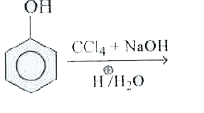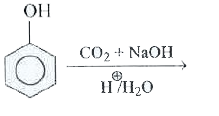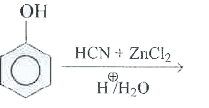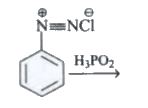Which one of the following reaction would produce secondary alcohol?
C6H5−O∣∣C−CH31.CH3MgBr−−−−−−−→2.H+
C6H5−O∣∣C−CH31.1.LiAIH4−−−−−−→2.H+
CH3CHO1.LiAIH4−−−−−→2.H+
CH3−O∣∣C−CH31.−OH−−−−→2.Br2
The correct Answer is:B
To determine which reaction produces a secondary alcohol, we need to analyze the given reactions step by step.
Step 1: Understand the structure of secondary alcohols
A secondary alcohol has the general structure where the carbon atom attached to the hydroxyl (OH) group is connected to one hydrogen atom and two alkyl groups (R1 and R2).
Step 2: Analyze the first reaction
The first reaction involves a Grignard reagent (C6H5C(=O)CH3 + MgBr). The Grignard reagent generates a nucleophile (CH3-) that attacks the carbonyl carbon. This leads to the formation of a tertiary alcohol because the carbon attached to the OH group will have no hydrogen atoms (it will be connected to three other carbons). Therefore, this reaction does not produce a secondary alcohol.
Step 3: Analyze the second reaction
The second reaction involves the reduction of a ketone (C6H5C(=O)CH3) using LiAlH4. Here, the hydride ion from LiAlH4 attacks the electron-deficient carbonyl carbon. The resulting structure has the OH group attached to a carbon that is connected to one hydrogen and two alkyl groups (C6H5 and CH3). This confirms that the product is a secondary alcohol.
Step 4: Analyze the third reaction
The third reaction involves the reduction of an aldehyde (CH3CHO) with LiAlH4. The hydride ion attacks the carbonyl carbon, resulting in a primary alcohol (since the carbon with the OH group is attached to two hydrogens and one alkyl group). Thus, this reaction does not yield a secondary alcohol.
Step 5: Analyze the fourth reaction
The fourth reaction involves a ketone (CH3C(=O)H) reacting with a base (OH-). The base abstracts a proton, forming a carbanion, which then attacks a bromine electrophile. This reaction does not lead to the formation of an alcohol; instead, it produces a bromo compound, which is not an alcohol.
Conclusion
Based on the analysis, the second reaction (C6H5C(=O)CH3 with LiAlH4) is the only one that produces a secondary alcohol.
Final Answer
The reaction that produces a secondary alcohol is the second option: C6H5C(=O)CH3 + LiAlH4.
---
A secondary alcohol has the general structure where the carbon atom attached to the hydroxyl (OH) group is connected to one hydrogen atom and two alkyl groups (R1 and R2).
The first reaction involves a Grignard reagent (C6H5C(=O)CH3 + MgBr). The Grignard reagent generates a nucleophile (CH3-) that attacks the carbonyl carbon. This leads to the formation of a tertiary alcohol because the carbon attached to the OH group will have no hydrogen atoms (it will be connected to three other carbons). Therefore, this reaction does not produce a secondary alcohol.
The second reaction involves the reduction of a ketone (C6H5C(=O)CH3) using LiAlH4. Here, the hydride ion from LiAlH4 attacks the electron-deficient carbonyl carbon. The resulting structure has the OH group attached to a carbon that is connected to one hydrogen and two alkyl groups (C6H5 and CH3). This confirms that the product is a secondary alcohol.
The third reaction involves the reduction of an aldehyde (CH3CHO) with LiAlH4. The hydride ion attacks the carbonyl carbon, resulting in a primary alcohol (since the carbon with the OH group is attached to two hydrogens and one alkyl group). Thus, this reaction does not yield a secondary alcohol.
The fourth reaction involves a ketone (CH3C(=O)H) reacting with a base (OH-). The base abstracts a proton, forming a carbanion, which then attacks a bromine electrophile. This reaction does not lead to the formation of an alcohol; instead, it produces a bromo compound, which is not an alcohol.
Based on the analysis, the second reaction (C6H5C(=O)CH3 with LiAlH4) is the only one that produces a secondary alcohol.
The reaction that produces a secondary alcohol is the second option: C6H5C(=O)CH3 + LiAlH4.
Topper's Solved these Questions
- ALCOHOLS, PHENOLS & ETHERSBOOK - VMC MODULES ENGLISHCHAPTER - ALCOHOLS, PHENOLS & ETHERSEXERCISE - Enable
100 Videos
- ALCOHOLS, PHENOLS & ETHERSBOOK - VMC MODULES ENGLISHCHAPTER - ALCOHOLS, PHENOLS & ETHERSEXERCISE - Efficient
98 Videos
- ALCOHOLS, PHENOLS & ETHERS BOOK - VMC MODULES ENGLISHCHAPTER - ALCOHOLS, PHENOLS & ETHERS EXERCISE - IN-CHAPTER EXERCISE - L
10 Videos
- ALDEHYDES,KETONES & CARBOXYLIC ACIDS BOOK - VMC MODULES ENGLISHCHAPTER - ALDEHYDES,KETONES & CARBOXYLIC ACIDS EXERCISE - IN-CHAPTER EXERCISE-M
10 Videos
Similar Questions
Knowledge Check
Which of the following reactions would produce same product?
A B
B C
C D
D
Which of the following reactions will produce benzene ?
A B3HC≡CHFeorCo−−−−−→ΔC
B3HC≡CHFeorCo−−−−−→ΔC D
D
Which of the following reactions will produce aldehyde?
A BH3C−CH=CH2CO+H2−−−−−−−→CO2(CO)8CH3C−C≡CH−−−−−→OϴH/H2ODH3C−C−o=ChHg+2,H2SO4−−−−−−−−→
BH3C−CH=CH2CO+H2−−−−−−−→CO2(CO)8CH3C−C≡CH−−−−−→OϴH/H2ODH3C−C−o=ChHg+2,H2SO4−−−−−−−−→
Which of the following reaction produces hydrogen ?
View SolutionWhich of the following reactions would give caproic acid ?
View SolutionWhich of the following reactions would give propanal ?
View SolutionWhich of the following rection given secondary alcohol?
View SolutionWhich one of the following reactions would produce secondary alcohol
View Solution
